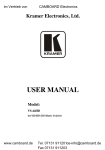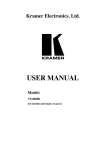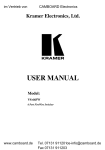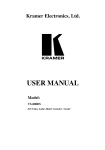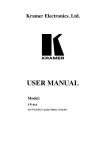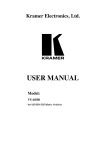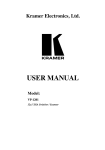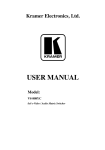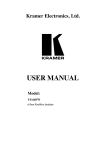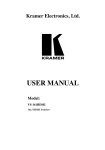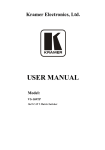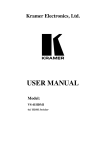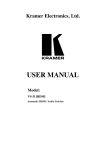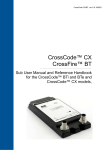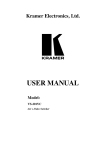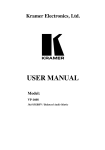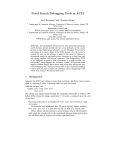Download USER MANUAL - BZB Express
Transcript
Kramer Electronics, Ltd. USER MANUAL Models: RC-80, Remote Control RC-160, Remote Control RC-160L, Remote Control Contents Contents 1 2 2.1 3 3.1 4 5 6 6.1 Introduction Getting Started Quick Start Overview Terminology Used in this User Manual Your RC-80, RC-160 and RC-160L Remote Control Machines Installing in a Rack Connecting the Remote Control Machine Connecting the Remote Control Rear Panel 1 1 1 2 4 4 9 10 11 6.1.1 Connecting via RS-232 13 6.2 Controlling via ETHERNET 13 6.2.1 6.2.2 Connecting the ETHERNET Port directly to a PC (Crossover Cable) Connecting the ETHERNET Port via a Network Hub (Straight-Through Cable) 13 14 6.3 6.4 6.5 7 7.1 Configuring the Ethernet Port Controlling via RS-485 Setting the DIP-switches Operating the Remote Control Machine Reading the Display 15 15 16 18 18 7.1.1 Viewing the Current Status 18 7.2 7.3 Switching OUT-IN Combinations Confirming Settings 19 20 7.3.1 Toggling between the At Once and Confirm Modes 20 7.4 Choosing the Audio-Follow-Video or Breakaway Option 21 7.4.1 7.4.2 Setting the Audio-Follow-Video Option Setting the Breakaway Option 21 21 7.5 8 8.1 8.2 8.3 9 10 Locking the Front Panel Flash Memory Upgrade Downloading from the Internet Connecting the PC to the RS-232 IN Port Upgrading Firmware Technical Specifications Kramer Protocol 2000 21 22 22 22 23 24 25 i Contents Figures Figure 1: RC-80 Remote Control Figure 2: RC-160 Remote Control Figure 3: RC-160L Remote Control Figure 4: Connecting the RC-160 Remote Control Figure 5: Connecting a Device without using a Null-modem Adapter Figure 6: Local Area Connection Properties Window Figure 7: Internet Protocol (TCP/IP) Properties Window Figure 8: Controlling via RS-485 Figure 9: RC-160 DIP-switches Figure 10: RC-160 Display Figure 11: The JTG Sender Window 5 6 7 12 13 14 14 16 16 18 23 Tables Table 1: Terminology Used in this User Manual Table 2: Front Panel RC-80/RC-160/RC-160L Remote Control Features Table 3: Rear Panel RC-80/RC-160/RC-160L Remote Control Features Table 4: Remote Control Configurations Table 5: DIP-switch Settings Table 6: Machine # DIP-switch Settings Table 7: Technical Specifications of the RC-80, RC-160 and RC-160L Table 8: Protocol Definitions Table 9: Instruction Codes for Protocol 2000 ii 4 8 8 10 16 17 24 25 26 KRAMER: SIMPLE CREATIVE TECHNOLOGY Introduction 1 Introduction Welcome to Kramer Electronics! Since 1981, Kramer Electronics has been providing a world of unique, creative, and affordable solutions to the vast range of problems that confront the video, audio, presentation, and broadcasting professional on a daily basis. In recent years, we have redesigned and upgraded most of our line, making the best even better! Our 1,000-plus different models now appear in 11 groups1 that are clearly defined by function. Congratulations on purchasing your RC-80, RC-160 and/or RC-160L which are ideal for broadcasting studios, and presentation and industrial applications. The package includes the following items: RC-80/RC-160/RC-160L Remote Controller Null-modem adapter Windows®-based Kramer control software2 Windows®-based Configuration Manager Kramer RC-IR2 Infrared Remote Control Transmitter (including the required battery and a separate user manual3) This user manual3 2 Getting Started We recommend that you: Unpack the equipment carefully and save the original box and packaging materials for possible future shipment Review the contents of this user manual Use Kramer high performance high resolution cables4 2.1 Quick Start This quick start chart summarizes the basic setup and operation steps. 1 GROUP 1: Distribution Amplifiers; GROUP 2: Switchers and Matrix Switchers; GROUP 3: Control Systems; GROUP 4: Format/Standards Converters; GROUP 5: Range Extenders and Repeaters; GROUP 6: Specialty AV Products; GROUP 7: Scan Converters and Scalers; GROUP 8: Cables and Connectors; GROUP 9: Room Connectivity; GROUP 10: Accessories and Rack Adapters; GROUP 11: Sierra Products 2 Downloadable from our Web site at http://www.kramerelectronics.com 3 Download up-to-date Kramer user manuals from our Web site at http://www.kramerelectronics.com 4 The complete list of Kramer cables is on our Web site at http://www.kramerelectronics.com 1 Overview R e m o t e C o nt r o l S w it c h e r RS-232 R e m o t e C o n t r ol S w it c he r Rem ot e Cont r ol Rem ot e Cont r ol S w it c he r RS-232 S w it c h e r Rem ot e C ont r ol RS-23 2 ETHERNET 3 Overview The Kramer RC-80, RC-160 and RC-160L are an innovative series of master remote control units, designed for broadcasting studios and industrial applications. The RC-160 and RC-160L can access and control Kramer machines that use Protocol 2000 (for example, a switcher that has up to 16 inputs and 16 outputs). The RC-80 can access and control Kramer machines that use Protocol 2000 (for example, a switcher that has up to eight inputs and eight outputs). The status of the controlled switcher is monitored continuously, and shown on the display. 2 KRAMER: SIMPLE CREATIVE TECHNOLOGY Overview In particular, the Remote Control machines: Have an LCD display (for the RC-160 and RC-160L) or a bright 7-segment LED display (for the RC-80) Feature two RS-232 ports (IN and OUT), an RS-485 port, an Ethernet interface, and an IR receiver Include Audio-follow-video and breakaway options Have a TAKE button, for confirming actions Include a LOCK button to prevent tampering with the front panel Receive their power from a 12V DC source, making them ideal also for field operation Control the RC-80/RC-160/RC-160L using the front panel buttons, or remotely via: RS-485 or RS-232 serial commands transmitted by a touch screen system, PC, or other serial controller The Kramer infrared remote control transmitter The Ethernet The RC-80/RC-160 is dependable, rugged, and fits into one vertical space (1U) of a standard 19” professional rack. The RC-160L fits into two vertical spaces (2U) of a standard 19” professional rack. To achieve the best performance: Connect only good quality connection cables, thus avoiding interference, deterioration in signal quality due to poor matching, and elevated noise levels (often associated with low quality cables) Avoid interference from neighboring electrical appliances that may adversely influence signal quality and position your Kramer Remote Control machine away from moisture, excessive sunlight and dust Caution – No operator-serviceable parts inside unit. Warning – Use only the Kramer Electronics input power wall adapter that is provided with this unit1. Warning – Disconnect power and unplug unit from wall before installing or removing device or servicing unit. 1 For example: model number AD2512C, part number 2535-000251 3 Your RC-80, RC-160 and RC-160L Remote Control Machines 3.1 Terminology Used in this User Manual Table 1 defines some terms that are used in this user manual. Table 1: Terminology Used in this User Manual Term Definition The standard specification for ETHERNET that is maintained by the Institute of Electrical and Electronics Engineers (IEEE). Dynamic Host Allows the network administrator to distribute IP addresses from a central point and Configuration automatically send a new IP address when an Ethernet point is plugged into a different Protocol (DHCP) network location Gateway A network position serving as an entry to another network. On the Internet, a node or stopping point can be either a gateway node or a host (end-point) node. IP Address A 32-binary digit number that identifies each sender or receiver (within a network via a particular server or workstation) of data (HTML pages or e-mails) that is sent in packets across the Internet. Every device connected to an IP network must have a unique IP address. This address is used to reference the specific unit. Local Area Network Computers sharing a common communications line or wireless link, which often share a (LAN) server within a defined geographic area. Media Access A computer's unique hardware number (or address) in a LAN or other network. On an Control (MAC) Ethernet LAN, the (MAC) address is identical to the Ethernet address. Address Transmission The basic communication language or protocol of the Internet that breaks the message Control into appropriately sized packets for the network, and can be used as a communications Protocol/Internet protocol in an intranet or an extranet. Protocol (TCP/IP) 802.3 4 Your RC-80, RC-160 and RC-160L Remote Control Machines This section defines each of the Remote Control machines: Figure 1 illustrates the RC-80 Remote Control Figure 2 illustrates the RC-160 Remote Control Figure 3 illustrates the RC-160L Remote Control Table 2 and Table 3 define the Remote Control machines1. 1 Some items, which appear in the table, do not appear in the illustrations since they are not included in that specific machine 4 KRAMER: SIMPLE CREATIVE TECHNOLOGY Your RC-80, RC-160 and RC-160L Remote Control Machines Figure 1: RC-80 Remote Control1 1 Item 9, which appears in Table 3 is not included in this machine 5 Your RC-80, RC-160 and RC-160L Remote Control Machines Figure 2: RC-160 Remote Control 6 KRAMER: SIMPLE CREATIVE TECHNOLOGY Your RC-80, RC-160 and RC-160L Remote Control Machines Figure 3: RC-160L Remote Control 7 Your RC-80, RC-160 and RC-160L Remote Control Machines Table 2: Front Panel RC-80/RC-160/RC-160L Remote Control Features # Feature Function RC-80 RC-160 RC-160L 1 IR Receiver 2 LOCK Button 3 OUT / OUTPUT SELECTOR Buttons1 Select the output to which the input is to be routed Select the input to switch to the output 5 IN / INPUT SELECTOR 1 Buttons VIDEO Button 6 AUDIO Button When button illuminates, actions relate to audio . Press to toggle 7 TAKE Button 8 STATUS Display When in the Confirm mode, press to implement a single action. Press to toggle between Confirm and At Once mode Displays the selected input switched to the output (marked above/below each input) 4 The red LED is illuminated when receiving signals from the Infra-red remote control transmitter Disengages the front panel switches From 1 to 8 From 1 to 16 From 1 to 8 From 1 to 16 From 1 to 16 From 1 to 16 2 When button illuminates, actions relate to video . Press to toggle 2 7-segment LED LCD LCD Table 3: Rear Panel RC-80/RC-160/RC-160L Remote Control Features # Feature Function RC-80 RC-160 RC-160L LCD Contrast Trimmer RS-485 Terminal Block Port RS-232 IN 9-pin D-sub Port Not applicable Turn to adjust LCD contrast3 Pins B (-) and A (+) are for RS-485; Pin G (Ground) may be connected to the shield of the cable if desired Connects to the PC or to another Remote Control Connects to a Kramer switcher or another Remote Control 13 RS-232 OUT 9-pin D-sub Port SETUP DIP-switches 14 Flash Upgrade Button 15 ETHERNET Connector Push in for “Program” to upgrade to the latest Kramer firmware (see section 8), or release for “Normal” (the factory default) Connects to the PC through computer networking (see section 6.2) 16 Reset Button ETHERNET factory reset button. Press to reset to factory default definitions4: IP number 192.168.139 Mask – 255.255.255.0 Gateway – 192.168.11 17 12V DC +12V DC connector for powering the unit 9 10 11 12 See section 6.4 1 The RC-80 and RC-160L have large buttons, and the RC-160 has small buttons 2 Press both VIDEO and AUDIO buttons (both buttons illuminate) for the audio channels to follow the video channels (AFV, audio-follow-video mode) 3 Insert a screwdriver into the hole and carefully rotate it, to trim the level 4 First disconnect the power adapter and then connect it again while pressing the Reset button. The unit will power up and load its memory with the factory default definitions 8 KRAMER: SIMPLE CREATIVE TECHNOLOGY Installing in a Rack 5 Installing in a Rack This section describes what to do before installing in a rack and how to rack mount. Before Installing in a Rack Before installing in a rack, be sure that the environment is within the recommended range: Operating temperature range +5º to +45º C (41º to 113º F) Operating humidity range 10 to 90% RHL, non-condensing Storage temperature range -20º to +70º C (-4º to 158º F) Storage humidity range 5 to 95% RHL, non-condensing How to Rack Mount To rack-mount a machine: 1. Attach both ear brackets to the machine. To do so, remove the screws from each side of the machine (3 on each side), and replace those screws through the ear brackets. CAUTION!! When installing in a 19" rack, avoid hazards by taking care that: 1. It is located within the recommended environmental conditions, as the operating ambient temperature of a closed or multi unit rack assembly may exceed the room ambient temperature. 2. Once rack mounted, enough air will still flow around the machine. 3. The machine is placed straight in the correct horizontal position. 4. You do not overload the circuit(s). When connecting the machine to the supply circuit, overloading the circuits might have a detrimental effect on overcurrent protection and supply wiring. Refer to the appropriate nameplate ratings for information. For example, for fuse replacement, see the value printed on the product label. 5. The machine is earthed (grounded) in a reliable way and is connected only to an electricity socket with grounding. Pay particular attention to situations where electricity is supplied indirectly (when the power cord is not plugged directly into the socket in the wall), for example, when using an extension cable or a power strip, and that you use only the power cord that is supplied with the machine. 2. Place the ears of the machine against the rack rails, and insert the proper screws (not provided) through each of the four holes in the rack ears. Note that: In some models, the front panel may feature built-in rack ears Detachable rack ears can be removed for desktop use Always mount the machine in the rack before you attach any cables or connect the machine to the power If you are using a Kramer rack adapter kit (for a machine that is not 19"), see the Rack Adapters user manual for installation instructions (you can download it at: http://www.kramerelectronics.com) 9 Connecting the Remote Control Machine 6 Connecting the Remote Control Machine The RC-160 Remote Control1 can be connected in several configurations, as defined in Table 4: Table 4: Remote Control Configurations 1 2 3 4 5 The Remote 2 Control is connected to the switcher via the 3 RS-232 ports Two or more Remote Control machines are connected in series to the switcher via the 3 RS-232 ports R e m o t e C o nt r o l RS-232 R e m o t e C o nt r o l R e m o t e C o nt r o l S w it c her RS-232 A PC is directly connected to the Remote Control, which is connected to the switcher4 via the 3 RS-232 ports R em o t e C o nt r o l S w it c he r RS-232 A PC is connected to the Remote Control via the Ethernet, and the Remote Control is connected to the switcher4 via the RS-232 ports3 One or more Remote Control machines are connected to the switcher via the RS-485 terminal block connectors S w it c her ETHERNET R e m o t e C o nt r o l S w it c h er RS-232 R em o t e C o nt r o l R em o t e C o nt r o l S w it c he r 1 From this section on, all the information is relevant to the RC-80, RC-160 and RC-160L, unless noted otherwise 2 The remote control can be operated either directly using the front panel buttons or via the IR transmitter controller. The commands are translated to the switcher via RS-232 or RS-485 3 A null-modem adapter is required when connecting via RS-232 4 Or to another remote control connected in series 10 KRAMER: SIMPLE CREATIVE TECHNOLOGY Connecting the Remote Control Machine This section describes how to connect: The Remote Control rear panel (see section 6.1) A switcher, an additional controller and/or a PC via the RS-232 ports (see section 6.1.1) A PC via the Ethernet (see section 6.2) and configure the Ethernet port (see section 6.3) Several Remote Control machines via RS-485 (see section 6.4) To set the DIP-switches, see section 6.5 6.1 Connecting the Remote Control Rear Panel To connect the RC-160 Remote Control as illustrated in the example in Figure 4, do the following: 1. Connect the A/V sources and acceptors, as required, to the Kramer switcher that is to be controlled. 2. Connect the RS-232 OUT port on the first1 RC-160 machine to the RS-232 port of a Kramer switcher (for example, the Kramer VS-1616V switcher), using a null modem adapter3. 3. If required, connect the RS-232 OUT port on a second2 RC-160 machine, to the RS-232 IN port of the first1 RC-160 machine, using a null modem adapter3. 4. If required, connect a PC to the RS-232 IN port of the second2 RC-160 machine4. 5. Turn on the power in the following order: The sources and acceptors on the Kramer switcher The Kramer switcher The Remote Control nearest to the switcher (the first unit in this example) The Remote Control further on the line (the second unit in this example) 6. Set the machine # to 1 on the controllers and the switcher (see section 6.5). 1 The remote control connected to the switcher 2 The remote control further away from the switcher 3 See section 6.1.1 4 Or to the Remote Control that is the furthest away from the switcher. For example, if only one Remote Control is connected to the switcher, connect the PC to this Remote Control; if three Remote Control machines are connected to the switcher, connect the PC to the third Remote Control in the line 11 Connecting the Remote Control Machine When controlling via RS-232, set the machine # to 1 on each machine (the controllers and the switcher) The STATUS display on both the remote control panels illuminate and after a few seconds will show the status of the connected switcher. If a “ ” message appears, refer to section 7.1. After the system is connected and powered, run the Windows®-based Kramer 1 control software on your PC Second Remote Control First Remote Control To the RS-232 Port of a Kramer Switcher Figure 4: Connecting the RC-160 Remote Control2 1 If the PC was connected 2 The dotted lines indicate an optional connection 12 KRAMER: SIMPLE CREATIVE TECHNOLOGY Connecting the Remote Control Machine 6.1.1 Connecting via RS-232 To connect a device1 to the Remote Control unit, using the Null-modem adapter provided with the machine (recommended): Connect the RS-232 9-pin D-sub rear panel port on your RC-160 unit to a 9-wire flat cable Connect the 9-wire flat cable to the Null-modem adapter Connect the Null-modem adapter to the RS-232 9-pin D-sub port on the device1 To connect a device1 to the RC-160 unit, without using a Null-modem adapter: Connect the RS-232 9-pin D-sub port on your device to the RS-232 9-pin D-sub rear panel port on the Master RC-160 unit, as Figure 5 illustrates PIN 5 Connected to PIN 5 (Ground) PIN 3 Connected to PIN 2 PIN 2 Connected to PIN 3 9-pin D-sub (From PC) 9-pin D-sub (Male) PIN 4 is connected to PIN 6 PINs 8, 7, 1 are connected together If a shielded cable is used, connect the shield to PIN 5 Figure 5: Connecting a Device without using a Null-modem Adapter 6.2 Controlling via ETHERNET You can connect the RC-160 via the Ethernet, using a crossover cable (see section 6.2.1) for direct connection to the PC or a straight through cable (see section 6.2.2) for connection via a network hub or network router. 6.2.1 Connecting the ETHERNET Port directly to a PC (Crossover Cable) You can connect the Ethernet port of the RC-160 to the Ethernet port on your PC, via a crossover cable with RJ-45 connectors. This type of connection is recommended for identification of the factory default IP Address of the RC-160 during the initial configuration After connecting the Ethernet port, configure your PC as follows: 1. Right-click the My Network Places icon on your desktop. 2. Select Properties. 1 A PC, an additional remote control, or a switcher 13 Connecting the Remote Control Machine 3. Right-click Local Area Connection Properties. 4. Select Properties. The Local Area Connection Properties window appears. 5. Select the Internet Protocol (TCP/IP) and click the Properties Button (see Figure 6). Figure 6: Local Area Connection Properties Window 6. Select Use the following IP address, and fill in the details as shown in Figure 7. 7. Click OK. Figure 7: Internet Protocol (TCP/IP) Properties Window 6.2.2 Connecting the ETHERNET Port via a Network Hub (Straight-Through Cable) You can connect the Ethernet port of the RC-160 to the Ethernet port on a network hub or network router, via a straight-through cable with RJ-45 connectors. 14 KRAMER: SIMPLE CREATIVE TECHNOLOGY Connecting the Remote Control Machine 6.3 Configuring the Ethernet Port After connecting the Ethernet port, you have to install and configure it. For detailed instructions on how to install and configure your Ethernet port, see the “Ethernet Configuration (FC-11) guide.pdf” on our Web site: http://www.kramerelectronics.com 6.4 Controlling via RS-485 You can connect several Remote Control units and a Kramer switcher, via the RS-485 port. For example, connect two remote control units and a Kramer switcher via the RS-485 port, as illustrated in Figure 8. When controlling via RS-485: Set the RS-485 Line Termination on the first and last machines in the line1 Set the same machine number on each machine2 (the controllers and the switcher), according to Table 6 in section 6.5. Do not set to machine #1 To connect two RC-160 units to a Kramer Switcher, do the following: 1. Connect the RS-485 terminal block port on the first RC-160 to the RS-485 port on the second RC-160 unit, as follows: Connect the “A” (+) PIN on the RS-485 rear panel port of the first RC-160 to the “A” (+) PIN on the RS-485 rear panel port of the second RC-160 unit Connect the “B” (-) PIN on the RS-485 rear panel port of the first RC-160 to the “B” (-) PIN on the RS-485 rear panel port of the second RC-160 unit When shielded twisted pair cable is used, the shield may be connected to the “G” (Ground) PIN if desired 2. Connect the second RC-160 unit to the Kramer switcher (for example, the VS-1616V) in the same fashion. 3. Set the DIP-switches3 on the RC-160 units and the switcher as follows: On the first unit, set DIP 8 ON (for RS-485 Line Termination with 120 ) and the machine # to 2 (DIP 2 ON) On the second unit, set the RS-485 Line Termination to OFF (DIP 8 ON) and the machine # to 2 (DIP 2 ON) On the Kramer switcher, set the RS-485 termination DIP-switch ON and set the Machine # to 2 (according to the instructions in that switcher’s user manual) 1 For RC-160, set DIP-switch 8 to ON. For the switcher, refer to its user manual 2 It is recommended to set the machine # according to the controlled switcher. in this example, the Switcher machine # was 2, so the controllers are set to machine# 2 3 In this example, the machine number is set to 2 15 Connecting the Remote Control Machine OFF ON 1 2 3 4 5 6 7 8 OFF ON 1 2 3 4 5 6 7 8 RS-485 PINOUT G _ B + A K r am er S w it c he r Figure 8: Controlling via RS-485 6.5 Setting the DIP-switches By default, all DIP-switches are set to OFF. Figure 9 illustrates the RC-160 DIP-switches: OFF ON 1 2 3 4 5 6 7 8 Figure 9: RC-160 DIP-switches Table 5: DIP-switch Settings DIPS 16 Function 1, 2, 3, 4 Machine number 5, 6, 7 8 Reserved RS-485 TERM Description See Table 6 Set to OFF ON for RS-485 Line Termination with 120 ; OFF for no RS-485 Line Termination KRAMER: SIMPLE CREATIVE TECHNOLOGY Connecting the Remote Control Machine Table 6 defines the Machine # DIP-switch settings: Table 6: Machine # DIP-switch Settings Mach. # 1 2 3 4 5 6 7 8 DIP 1 ON OFF ON OFF ON OFF ON OFF DIP 2 OFF ON ON OFF OFF ON ON OFF DIP 3 OFF OFF OFF ON ON ON ON OFF DIP 4 OFF OFF OFF OFF OFF OFF OFF ON Mach. # 9 10 11 12 13 14 15 DIP 1 ON OFF ON OFF ON OFF ON DIP 2 OFF ON ON OFF OFF ON ON DIP 3 OFF OFF OFF ON ON ON ON DIP 4 ON ON ON ON ON ON ON When connecting several controllers and a switcher, the machine numbers of all the units within the system should be identical. When controlling a system via: RS-232, set the machine number on all units to 1 (see section 6.1) RS-485, set the same machine # on all units excluding #1 (see section 6.4) If, for example, the controlled switcher is set to machine # 3, then the connected controllers should also be set to # 3 17 Operating the Remote Control Machine 7 Operating the Remote Control Machine This section describes how to: Read the display (see section 7.1) and view the current status (see section 7.1.1) Switch OUT-IN combinations (see 7.2) Confirm settings (see section 7.3) Choose the audio-follow-video or the breakaway feature (see section 7.4) Lock the front panel (see section 7.5) 7.1 Reading the Display The input Status is displayed on LCD for the RC-160 and RC-160L machines, and displayed on a 7-segment display for the RC-80. Upon connecting the power to the unit, the display shows: During normal operation, the display shows the inputs switched to the outputs1, as illustrated in Figure 10: Figure 10: RC-160 Display In case of a communication problem, the display shows: Check that all units are turned ON and that the cables are properly connected Remember to power OFF and ON after any DIP-switch change 7.1.1 Viewing the Current Status The RC-160 shows the status of the last switched output by illuminating the corresponding IN and OUT buttons. To view the current setting of an output, press the corresponding OUT button. If an input is connected to this output, the corresponding IN button will illuminate. 1 For example, when an 8x8 switcher is connected 18 KRAMER: SIMPLE CREATIVE TECHNOLOGY Operating the Remote Control Machine 7.2 Switching OUT-IN Combinations To operate the machine, enter the inputs and outputs to be connected: For matrices, use both the IN and the OUT keys For switchers (only one output) use only the IN keys You can switch an input to an output in the At Once mode1 or the Confirm mode1. To switch a video/audio input to a video/audio output in the At Once mode2, do the following: 1. Press an OUT button. The selected OUT button and the IN button, which is currently switched to that output, are illuminated. 2. Press an IN button to select the input to switch to the output. The new IN button illuminates and the display shows the new input number, which is switched to the output. To disconnect an input that is switched to an output, press the illuminated input button (or press any input button twice). The input button no longer illuminates and the input is disconnected from the output. To switch a video/audio input to a video/audio output in the Confirm mode2, do the following: 1. Press an OUT button. The selected OUT button and the IN button, which is currently switched to that output, are illuminated. 2. Press an IN button to select the input to switch to the output. The previously selected input button is no longer illuminated, the TAKE button blinks and the display shows the newly selected input number blinking3. 3. Press the TAKE button to confirm the action. The selected IN button illuminates, the take button illuminates and the display shows the new input that is switched to the output. 1 See section 7.3 2 See section 7.3.1 to select At Once mode/ Confirm mode 3 To abort the action, press any OUT button 19 Operating the Remote Control Machine 7.3 Confirming Settings You can choose to work in the At Once or the Confirm mode. In the At Once mode (TAKE button is dim): Pressing an OUT-IN combination implements the switch immediately You save time as execution is immediate and actions require no user confirmation No protection is offered against changing an action in error In the Confirm mode (TAKE button is lit): You can key-in an action and then confirm it by pressing the TAKE button Every action requires user confirmation, protecting against erroneous switching Execution is delayed1 until the user confirms the action 7.3.1 Toggling between the At Once and Confirm Modes To toggle between the At Once and Confirm modes, do the following: 1. Press the darkened TAKE button to toggle from the At Once mode (in which the TAKE button does not illuminate) to the Confirm mode (in which the TAKE button illuminates). Actions now require user confirmation and the TAKE button illuminates. 2. Press the illuminated TAKE button to toggle from the Confirm mode back to the At Once mode. Actions no longer require user confirmation and the TAKE button no longer illuminates. 1 Failure to press the TAKE button within 45 seconds (the Timeout) will abort the action 20 KRAMER: SIMPLE CREATIVE TECHNOLOGY Operating the Remote Control Machine 7.4 Choosing the Audio-Follow-Video or Breakaway Option You can switch stereo audio signals in one of two ways, either: Audio-follow-video (AFV), in which all operations relate to both the video and the audio channels; or Breakaway, in which video and audio channels switch independently 7.4.1 Setting the Audio-Follow-Video Option To set the Audio-follow-video (AFV) option, press the AUDIO and VIDEO buttons1 simultaneously. Both the AUDIO and the VIDEO buttons illuminate and the audio will follow the video. 7.4.2 Setting the Breakaway Option To set the Breakaway option: Press either the AUDIO (for audio control only) or the VIDEO (for video control only) button: If the AUDIO button illuminates, switching operations relate to Audio If the VIDEO button illuminates, switching operations relate to Video 7.5 Locking the Front Panel To prevent changing the settings accidentally or tampering with the unit via the front panel buttons, lock2 your RC-160. Unlocking releases the protection mechanism. To lock the RC-160: Press and hold the LOCK button until the LOCK button is illuminated The front panel is locked. Pressing a button will have no effect To unlock the RC-160: Press and hold the illuminated LOCK button until the LOCK button is no longer illuminated The front panel unlocks 1 The AUDIO and VIDEO buttons relate only to the Remote Control, they do not affect the controlled switcher. For example, if the switcher is in the audio mode and the controller is in the VIDEO mode, the Switcher’s display might indicate the audio mode but the controller routes the video channels only 2 Nevertheless, even though the front panel is locked you can still operate via RS-232 or RS-485, as well as via the Kramer RC-IR1 Infrared Remote Control Transmitter 21 Flash Memory Upgrade 8 Flash Memory Upgrade The RC-160 firmware is located in FLASH memory, which lets you upgrade to the latest Kramer firmware version in minutes! The process involves: Downloading from the Internet (see section 8.1) Connecting the PC to the RS-232 IN port (see section 8.2) Upgrading Firmware (see section 8.3) 8.1 Downloading from the Internet You can download the up-to-date file1 from the Internet. To do so: 1. Go to our Web site at http://www.kramerelectronics.com and download the file: “JTG_RC-160.zip” from the Technical Support section. 2. Extract the file: “JTG_RC-160.zip” to a folder (for example, C:\Program Files\Kramer Flash). 3. Install the JTG-Sender application. 8.2 Connecting the PC to the RS-232 IN Port Before installing the latest Kramer firmware version on a RC-160 unit, do the following: 1. Connect the RS-232 IN 9-pin D-sub rear panel port on the RC-160 unit to the Null-modem adapter and connect the Null-modem adapter with a 9-wire flat cable to the RS-232 9-pin D-sub COM port on your PC (see section 6.1.1). 2. On the rear panel, push in the Flash Upgrade button (to program), using a screwdriver. 3. Connect the power on the RC-160 unit and switch it ON. 1 The files indicated in this section are given as an example only. The actual file names can be modified 22 KRAMER: SIMPLE CREATIVE TECHNOLOGY Flash Memory Upgrade 8.3 Upgrading Firmware Follow these steps to upgrade the firmware: 1. Double click the JTG-Sender desktop icon. The JTG-Sender window appears (see Figure 11). Figure 11: The JTG Sender Window 2. Select the required COM Port1. 3. Press the File button to select the .jtg firmware file included in the package. 4. Press the Send button to download the file. The Send button lights green. 5. Wait until downloading is completed and the green Send button turns off. 1 To which the Remote Control is connected on your PC 23 Technical Specifications 9 Technical Specifications Table 7 includes the technical specifications: 1 Table 7: Technical Specifications of the RC-80, RC-160 and RC-160L INPUTS/OUTPUTS: 2 RS-232 9-pin D-sub IN/OUT connectors 1 RS-485 connector on detachable terminal blocks 1 Ethernet CAT 5 port 2 CONTROLS: Front panel buttons, RS-232, RS-485, Ethernet and IR, LCD contrast trimmer POWER SOURCE: RC-80: 12V DC, 200mA RC-160/RC-160L: 12V DC, 130mA RC-80, RC-160: 19-inch (W), 2-inch (D) 1U (H) rack-mountable DIMENSIONS: RC-160L: 19-inch (W), 2-inch (D) 2U (H) rack-mountable RC-80, RC-160: 2.7 kg (6lbs.) approx WEIGHT: RC-160L: 3.5 kg (7.8lbs.) approx. ACCESSORIES: Null modem adapter, Windows®-based Kramer control software, Windows®-based Configuration Manager, Infrared remote control transmitter 1 Specifications are subject to change without notice 2 For RC-160 and RC-160L only 24 KRAMER: SIMPLE CREATIVE TECHNOLOGY Kramer Protocol 2000 10 Kramer Protocol 20001 The RC-80, RC-160, and RC-160L communicate with machines controlled using Protocol 2000 (version 0.46) (below). This communication protocol uses four bytes of information as defined below. For RS-232, a null-modem connection between the machine and controller is used. The default data rate for RS-232/RS-485 is 9600 baud, with no parity, 8 data bits and 1 stop bit. Table 8: Protocol Definitions MSB LSB DESTINATION INSTRUCTION 0 7 D 6 N5 5 N4 4 N3 3 1 7 I6 6 I5 5 I4 4 I3 3 O6 6 O5 5 O4 4 O3 3 OVR 6 X 5 M4 4 M3 3 1st byte N2 2 N1 1 N0 0 I2 2 I1 1 I0 0 O2 2 O1 1 O0 0 INPUT 2nd byte OUTPUT 1 7 3rd byte MACHINE NUMBER 1 7 M2 2 M1 1 M0 0 4th byte 1st BYTE: Bit 7 – Defined as 0. D – “DESTINATION” : 0 - for sending information to the switchers (from the PC); 1 - for sending to the PC (from the switcher). N5…N0 – “INSTRUCTION” The function that is to be performed by the switcher(s) is defined by the INSTRUCTION (6 bits). Similarly, if a function is performed via the machine’s keyboard, then these bits are set with the INSTRUCTION NO., which was performed. The instruction codes are defined according to the table below (INSTRUCTION NO. is the value to be set for N5…N0). 2nd BYTE: Bit 7 – Defined as 1. I6…I0 – “INPUT” . When switching (ie. instruction codes 1 and 2), the INPUT (7 bits) is set as the input number which is to be switched. Similarly, if switching is done via the machine’s front-panel, then these bits are set with the INPUT NUMBER which was switched. For other operations, these bits are defined according to the table. 3rd BYTE: Bit 7 – Defined as 1. O6…O0 – “OUTPUT” . When switching (ie. instruction codes 1 and 2), the OUTPUT (7 bits) is set as the output number which is to be switched. Similarly, if switching is done via the machine’s front-panel, then these bits are set with the OUTPUT NUMBER which was switched. For other operations, these bits are defined according to the table. 4th BYTE: Bit 7 – Defined as 1. Bit 5 – Don’t care. OVR – Machine number override. M4…M0 – MACHINE NUMBER. Used to address machines in a system via their machine numbers. When several machines are controlled from a single serial port, they are usually configured together with each machine having an individual machine number. If the OVR bit is set, then all machine numbers will accept (implement) the command, and the addressed machine will reply. 1 You can download our user-friendly “Software for Calculating Hex Codes for Protocol 2000” from the technical support section on our Web site at: http://www.kramerelectronics.com 25 Kramer Protocol 2000 For a single machine controlled via the serial port, always set M4…M0 = 1, and make sure that the machine itself is configured as MACHINE NUMBER = 1. Table 9: Instruction Codes for Protocol 2000 Note: All values in the table are decimal, unless otherwise stated. INSTRUCTION # 0 1 RESET VIDEO SWITCH VIDEO 2 SWITCH AUDIO 3 STORE VIDEO STATUS RECALL VIDEO STATUS REQUEST STATUS OF A VIDEO OUTPUT REQUEST STATUS OF AN AUDIO OUTPUT VIS SOURCE 4 5 6 7 DEFINITION FOR SPECIFIC INSTRUCTION DESCRIPTION 8 BREAKAWAY SETTING 9 VIDEO / AUDIO TYPE SETTING OUTPUT 0 Set equal to video input which is to be switched (0 = disconnect) Set equal to audio input which is to be switched (0 = disconnect) Set as SETUP # 0 Set equal to video output which is to be switched (0 = to all the outputs) Set equal to audio output which is to be switched (0 = to all the outputs) 0 - to store 1 - to delete 0 1 2, 15 Equal to output number whose status is reqd Equal to output number whose status is reqd 4, 3 Set as SETUP # Set as SETUP # Set as SETUP # Set as input # when OUTPUT byte = 6; OR set as output # when OUTPUT byte = 7; OR set as blank period (in steps of 25ms) when OUTPUT byte = 32; OR set = 0. ***** 0 1 0 - for video 1 - for audio 2 - for VGA and DVI 10 REQUEST VIS SETTING 11 REQUEST BREAKAWAY SETTING REQUEST VIDEO / AUDIO TYPE SETTING SET HIGHEST MACHINE ADDRESS REQUEST HIGHEST MACHINE ADDRESS 12 13 14 26 NOTE INPUT Set as SETUP #, or set to 126 or 127 to request if machine has this function Set as SETUP #, or set to 126 or 127 to request if machine has this function Set as SETUP #, or set to 126 or 127 to request if machine has this function 0 - for video 1 - for audio 0 - for video 1 - for audio 0 - No VIS (immediate) 1 - Input # 1 2 - External digital sync 3 - External analog sync 4 - Dynamic sync 5 - Inter-machine sync 6 - Input # (INPUT byte) 7 - Output #(INPUT byte) 8 - User-defined sync 32 - RGBHV seamless switching 64 - Set for delayed switch 65 - Execute delayed switch 66 - Cancel delayed switch setting 0 - audio-follow-video 1 - audio breakaway 0 - FOLLOW mode 1 - Normal mode 0 - CV 4 - SDI 1 - YC 5 - CV+YC 2 - YUV 6 - VGA scaler 3 - RGBS 7 - DVI O0=0 – Unbalanced audio O0=1 – Balanced audio O1=0 – Digital audio O1=1 – Analog audio O4=0, O3=0, O2=0-Mono O4=0, O3=0,O2=1-Stereo 1 - 640X480 2 - 800X600 3 - 1024X768 0 - VIS source 1 - Input # or output # of source 2 - Vertical sync freq (Hz) 0 - Request audio breakaway setting 1 - Request “FOLLOW” setting 0 - for video 1 - for audio 2 - for VGA Set equal to highest machine address 0 2 2, 3, 15 2, 3, 15 4, 3 2, 5, 17, 18 2 15 2 3, 4, 6, 7 3, 4, 6, 15 3, 4, 6 2 4 KRAMER: SIMPLE CREATIVE TECHNOLOGY Kramer Protocol 2000 INSTRUCTION # 15 16 17 18 19 20 21 DEFINITION FOR SPECIFIC INSTRUCTION DESCRIPTION INPUT NOTE OUTPUT REQUEST WHETHER SETUP IS DEFINED / VALID INPUT IS DETECTED ERROR / BUSY SETUP # or Input # 0 - for checking if setup is defined 8 1 - for checking if input is valid For invalid / valid input (i.e. OUTPUT byte = 4 or OUTPUT byte = 5), this byte is set as the input # RESERVED RESET AUDIO STORE AUDIO STATUS RECALL AUDIO STATUS SET VIDEO PARAMETER ---0 Set as SETUP # 0 - error 1 - invalid instruction 2 - out of range 3 - machine busy 4 - invalid input 5 - valid input ---0 0 - to store 1 - to delete 0 Set as SETUP # Equal to input / output number whose video parameter is to be set (0 = all) Equal to input / output number whose gain is to be set (0 = all) Equal to input / output number whose video parameter is to be increased / decreased (0 = all) 9, 25 10 1 2, 3 2, 3 Set as parameter value 2, 11, 24 Set as parameter value 2, 11, 24 0 - increase video gain 1 - decrease video gain 2 - increase contrast 3 - decrease contrast 4 - increase brightness 5 - decrease brightness 6 - increase color 7 - decrease color 8 - increase hue 9 - decrease hue 16 - increase H-phase 17 - decrease H-phase 18 - increase V-position 19 - decrease V-position 0 - increase output 1 - decrease output 2 - increase left output 3 - decrease left output 4 - increase right output 5 - decrease right output 6 - increase input 7 - decrease input 8 - increase left input 9 - decrease left input 10 - increase right input 11 - decrease right input 0 24 6, 24 0 6, 24 22 SET AUDIO PARAMETER 23 INCREASE / DECREASE VIDEO PARAMETER 24 INCREASE / DECREASE AUDIO PARAMETER Equal to input / output number whose parameter is to be increased / decreased (0 = all) 25 REQUEST AUDIO PARAMETER Equal to input / output number whose parameter is requested 26 REQUEST VIDEO PARAMETER Equal to input / output number whose video parameter is requested 30 LOCK FRONT PANEL 2 REQUEST WHETHER PANEL IS LOCKED RESERVED 0 - Panel unlocked 1 - Panel locked 0 0 31 0 16 ---- ---- 10 Memory address Data 20 32 to 35 40 DIRECT MEMORY SAVE 24 27 Kramer Protocol 2000 INSTRUCTION # DEFINITION FOR SPECIFIC INSTRUCTION DESCRIPTION INPUT NOTE OUTPUT 42 AUDIO PARAMETER SETTINGS FOR INSTRUCTIONS 22, 24, 25 INPUT Bit: I0 - 0=input; 1=output I1 - Left I2 - Right 0 - Gain 1 - Bass 2 - Treble 3 - Midrange 24 43 VIDEO PARAMETER SETTINGS FOR INSTRUCTIONS 21, 23, 26 1 – Input 2 – Output 24 56 CHANGE TO ASCII 0 57 SET AUTO-SAVE 58 59 EXECUTE LOADED DATA LOAD VIDEO DATA I3 - no save I4 - auto-save Set as 0, or as SETUP #. 0 - video gain 1 - contrast 2 - brightness 3 - color 4 - hue 5 - H-phase 6 - V-position 1 - SVS protocol 2 - Generic protocol 0 60 LOAD AUDIO DATA 61 IDENTIFY MACHINE 62 DEFINE MACHINE 63 EXTENDED DATA NOTES on the above table: Set equal to video input (0 = disconnect) 1-Take 2-Cancel Set equal to video output (0 = to all the outputs) (127 = load SETUP #) or SETUP # Set equal to audio input (0 = disconnect) Set equal to audio output (0 = to all the outputs) (127 = load SETUP #) 1 - video machine name 2 - audio machine name 3 - video software version 4 - audio software version 5 - RS422 controller name 6 - RS422 controller version 7 - remote control name 8 - remote software version 9 - Protocol 2000 revision 1 - number of inputs 2 - number of outputs 3 - number of setups or SETUP # 0 - Request first 4 digits 1 - Request first suffix 2 - Request second suffix 3 - Request third suffix 10 - Request first prefix 11 - Request second prefix 12 - Request third prefix 7 MSBs for INPUT data 1 - for video 2 - for audio 3 - for SDI 4 - for remote panel 5 - for RS-422 controller 7 MSBs for OUTPUT data 19 12, 2 22, 3 22, 23 22, 23 13 14 20 NOTE 1 - When the master switcher is reset, (e.g. when it is turned on), the reset code is sent to the PC. If this code is sent to the switchers, it will reset according to the present power-down settings. NOTE 2 - These are bi-directional definitions. That is, if the switcher receives the code, it will perform the instruction; and if the instruction is performed (due to a keystroke operation on the front panel), then these codes are sent. For example, if the HEX code 01 85 88 83 was sent from the PC, then the switcher (machine 3) will switch input 5 to output 8. If the user switched input 1 to output 7 via the front panel keypad, then the switcher will send HEX codes: 41 81 87 83 to the PC. When the PC sends one of the commands in this group to the switcher, then, if the instruction is valid, the switcher replies by sending to the PC the same four bytes that it was sent (except for the first byte, where the DESTINATION bit is set high). NOTE 3 - SETUP # 0 is the present setting. SETUP # 1 and higher are the settings saved in the switcher' s memory, (i.e. those used for Store and Recall). NOTE 4 - The reply to a "REQUEST" instruction is as follows: the same instruction and INPUT codes as were sent are returned, and the OUTPUT is assigned the value of the requested parameter. The replies to instructions 10 and 11 are as per the definitions in instructions 7 and 8 respectively. For example, if the present status of machine number 5 is breakaway setting, then the reply to the HEX code 0B 80 80 85 would be HEX codes 4B 80 81 85 28 KRAMER: SIMPLE CREATIVE TECHNOLOGY Kramer Protocol 2000 NOTE 5 – For the OUTPUT byte set as 6, the VIS source is the input selected using the OUTPUT byte. Similarly, for the OUTPUT byte set as 7, the VIS source is the output selected using the OUTPUT byte. Note also, that on some machines the sync source is not software selectable, but is selected using switches, jumpers, etc! NOTE 6 – If INPUT is set to 127 for these instructions, then, if the function is defined on this machine, it replies with OUTPUT=1. If the function is not defined, then the machine replies with OUTPUT=0, or with an error (invalid instruction code). If the INPUT is set to 126 for these instructions, then, if possible, the machine will return the current setting of this function, even for the case that the function is not defined. For example, for a video switcher which always switches during the VIS of input #1, (and its VIS setting cannot be programmed otherwise), the reply to the HEX code 0A FE 80 81 (ie. request VIS setting, with INPUT set as 126dec) would be HEX codes 4A FE 81 81 (ie. VIS setting = 1, which is defined as VIS from input #1). NOTE 7 – Setting OUTPUT to 0 will return the VIS source setting as defined in instruction #7. Setting to 1 will return the input # or output # of the sync source (for the case where the VIS source is set as 6 or as 7 in instruction #7). Setting to 2 returns the vertical sync frequency (0 for no input sync, 50 for PAL, 60 for NTSC, 127 for error). NOTE 8 - The reply is as in TYPE 3 above, except that here the OUTPUT is assigned with the value 0 if the setup is not defined / no valid input is detected; or 1 if it is defined / valid input is detected. NOTE 9 - An error code is returned to the PC if an invalid instruction code was sent to the switcher, or if a parameter associated with the instruction is out of range (e.g. trying to save to a setup greater than the highest one, or trying to switch an input or output greater than the highest one defined). This code is also returned to the PC if an RS-232 instruction is sent while the machine is being programmed via the front panel. Reception of this code by the switcher is not valid. NOTE 10 – This code is reserved for internal use. NOTE 11 – For machines where the video and / or audio gain is programmable. NOTE 12 - Under normal conditions, the machine' s present status is saved each time a change is made. The "power-down" save (auto-save) may be disabled using this code. Note that whenever the machine is turned on, the auto-save function is set. NOTE 13 - This is a request to identify the switcher/s in the system. If the OUTPUT is set as 0, and the INPUT is set as 1, 2, 5 or 7, the machine will send its name. The reply is the decimal value of the INPUT and OUTPUT. For example, for a 2216, the reply to the request to send the audio machine name would be (HEX codes): 7D 96 90 81 (i.e. 128dec+ 22dec for 2nd byte, and 128dec+ 16dec for 3rd byte). If the request for identification is sent with the INPUT set as 3 or 4, the appropriate machine will send its software version number. Again, the reply would be the decimal value of the INPUT and OUTPUT - the INPUT representing the number in front of the decimal point, and the OUTPUT representing the number after it. For example, for version 3.5, the reply to the request to send the version number would be (HEX codes): 7D 83 85 81 (i.e. 128dec+ 3dec for 2nd byte, 128dec+ 5dec for 3rd byte). If the OUTPUT is set as 1, then the ASCII coding of the lettering following the machine’s name is sent. For example, for the VS-7588YC, the reply to the request to send the first suffix would be (HEX codes): 7D D9 C3 81 (i.e. 128dec+ ASCII for “Y” ; 128dec+ ASCII for “C” ). NOTE 14 - The number of inputs and outputs refers to the specific machine which is being addressed, not to the system. For example, if six 16X16 matrices are configured to make a 48X32 system (48 inputs, 32 outputs), the reply to the HEX code 3E 82 81 82 (ie. request the number of outputs) would be HEX codes 7E 82 90 82 ie. 16 outputs NOTE 15 – When the OVR bit (4th byte) is set, then the “video” commands have universal meaning. For example, instruction 1 (SWITCH VIDEO) will cause all units (including audio, data, etc.) to switch. Similarly, if a machine is in “FOLLOW” mode, it will perform any “video” instruction. NOTE 16 - The reply to the “REQUEST WHETHER PANEL IS LOCKED” is as in NOTE 4 above, except that here the OUTPUT is assigned with the value 0 if the panel is unlocked, or 1 if it is locked. NOTE 17 – For clean switching of RGBHV video, the “seamless switching” option may be used. The blanking period for the transition of the RGB sources may be set in this case, in steps of 25 milliseconds. For example, to set for 350ms blanking time (14 steps), send HEX codes 07 8E A0 81 29 Kramer Protocol 2000 NOTE 18 – Delayed execution allows switching after a delay dictated by RS-232. To do this, the user sends instruction 7 with the “Set for delayed switch” option (64dec) before sending the switch command (instruction 1) or pressing via front panel. The switch is not executed (unless timed-out) until the “Execute delayed switch” code is sent, or the “Set for delayed switch” code is sent again. (The mode is automatically cancelled after implementation of the switch if the “execute” command is used). For example, to connect input 4 to output 3 after a delay, send HEX codes 07 80 C0 81 (set for delayed switch) 01 84 83 81 (switch code) then, after the required delay, send HEX codes 07 80 C1 81 (execute delayed switch) to implement the switch. NOTE 19 – After this instruction is sent, the unit will respond to the ASCII command set defined by the OUTPUT byte. The ASCII command to operate with the HEX command set must be sent in order to return to working with HEX codes. NOTE 20 – When data (ie. the INPUT and/or OUTPUT bytes) of more than 7 bits is required, this instruction is sent before sending the instruction needing the additional bits. The data in this intruction then becomes the Most Significant Bits of that next instruction. For example, to set the audio gain (instruction 22) of output 3 to 681dec (2A9hex), you would first send HEX codes 3F 80 85 81 and then send HEX codes 16 83 A9 81. To set the audio gain of output 6 to 10013dec (271Dhex), first send HEX codes 3F 80 CE 81 followed by HEX codes 16 86 9D 81. NOTE 21 – To store data in the non-volatile memory of the unit, eg. the EEPROM for saving SETUPS. The EEPROM address is sent using the INPUT byte, and the data to be stored is sent using the OUTPUT byte. To use this instruction, it is necessary to understand the memory map, and memory structure of the particular machine. NOTE 22 – Instruction 59 and instruction 60 load data for sending to the crosspoint switcher (or for storing in a SETUP), ie. the data is “lined-up” to be executed later. Instruction 58 executes the loaded data. NOTE 23 – If the INPUT byte is set as 127dec, then the data stored in a SETUP is loaded. The SETUP # is in the OUTPUT byte. NOTE 24 – Further information needed in instructions 21, 22, 25 and 26, is sent using instruction 42 – which is sent prior to the instruction. For example, to request the audio gain value of right input # 9, send hex codes 2A 84 80 81 and then send HEX codes 19 89 81 81. NOTE 25 – For units which detect the validity of the video inputs, Instruction 16 will be sent whenever the unit detects a change in the state of an input (in real-time). For example, if input 3 is detected as invalid, the unit will send the HEX codes 10 83 84 81 If input 7 is detected as valid, then the unit will send HEX codes 10 87 85 81. 30 KRAMER: SIMPLE CREATIVE TECHNOLOGY LIMITED WARRANTY Kramer Electronics (hereafter Kramer) warrants this product free from defects in material and workmanship under the following terms. HOW LONG IS THE WARRANTY Labor and parts are warranted for seven years from the date of the first customer purchase. WHO IS PROTECTED? Only the first purchase customer may enforce this warranty. WHAT IS COVERED AND WHAT IS NOT COVERED Except as below, this warranty covers all defects in material or workmanship in this product. The following are not covered by the warranty: 1. Any product which is not distributed by Kramer, or which is not purchased from an authorized Kramer dealer. If you are uncertain as to whether a dealer is authorized, please contact Kramer at one of the agents listed in the Web site www.kramerelectronics.com. 2. Any product, on which the serial number has been defaced, modified or removed, or on which the WARRANTY VOID IF TAMPERED sticker has been torn, reattached, removed or otherwise interfered with. 3. Damage, deterioration or malfunction resulting from: i) Accident, misuse, abuse, neglect, fire, water, lightning or other acts of nature ii) Product modification, or failure to follow instructions supplied with the product iii) Repair or attempted repair by anyone not authorized by Kramer iv) Any shipment of the product (claims must be presented to the carrier) v) Removal or installation of the product vi) Any other cause, which does not relate to a product defect vii) Cartons, equipment enclosures, cables or accessories used in conjunction with the product WHAT WE WILL PAY FOR AND WHAT WE WILL NOT PAY FOR We will pay labor and material expenses for covered items. We will not pay for the following: 1. Removal or installations charges. 2. Costs of initial technical adjustments (set-up), including adjustment of user controls or programming. These costs are the responsibility of the Kramer dealer from whom the product was purchased. 3. Shipping charges. HOW YOU CAN GET WARRANTY SERVICE 1. To obtain service on you product, you must take or ship it prepaid to any authorized Kramer service center. 2. Whenever warranty service is required, the original dated invoice (or a copy) must be presented as proof of warranty coverage, and should be included in any shipment of the product. Please also include in any mailing a contact name, company, address, and a description of the problem(s). 3. For the name of the nearest Kramer authorized service center, consult your authorized dealer. LIMITATION OF IMPLIED WARRANTIES All implied warranties, including warranties of merchantability and fitness for a particular purpose, are limited in duration to the length of this warranty. EXCLUSION OF DAMAGES The liability of Kramer for any effective products is limited to the repair or replacement of the product at our option. Kramer shall not be liable for: 1. Damage to other property caused by defects in this product, damages based upon inconvenience, loss of use of the product, loss of time, commercial loss; or: 2. Any other damages, whether incidental, consequential or otherwise. Some countries may not allow limitations on how long an implied warranty lasts and/or do not allow the exclusion or limitation of incidental or consequential damages, so the above limitations and exclusions may not apply to you. This warranty gives you specific legal rights, and you may also have other rights, which vary from place to place. NOTE: All products returned to Kramer for service must have prior approval. This may be obtained from your dealer. This equipment has been tested to determine compliance with the requirements of: EN-50081: EN-50082: CFR-47: "Electromagnetic compatibility (EMC); generic emission standard. Part 1: Residential, commercial and light industry" "Electromagnetic compatibility (EMC) generic immunity standard. Part 1: Residential, commercial and light industry environment". FCC* Rules and Regulations: Part 15: “Radio frequency devices Subpart B Unintentional radiators” CAUTION! Servicing the machines can only be done by an authorized Kramer technician. Any user who makes changes or modifications to the unit without the expressed approval of the manufacturer will void user authority to operate the equipment. Use the supplied DC power supply to feed power to the machine. Please use recommended interconnection cables to connect the machine to other components. * FCC and CE approved using STP cable (for twisted pair products) 31 For the latest information on our products and a list of Kramer distributors, visit our Web site: www.kramerelectronics.com, where updates to this user manual may be found. We welcome your questions, comments and feedback. Safety Warning: Disconnect the unit from the power supply before opening/servicing. Caution Kramer Electronics, Ltd. Web site: www.kramerelectronics.com E-mail: [email protected] P/N: 2900-000114 REV 5



































